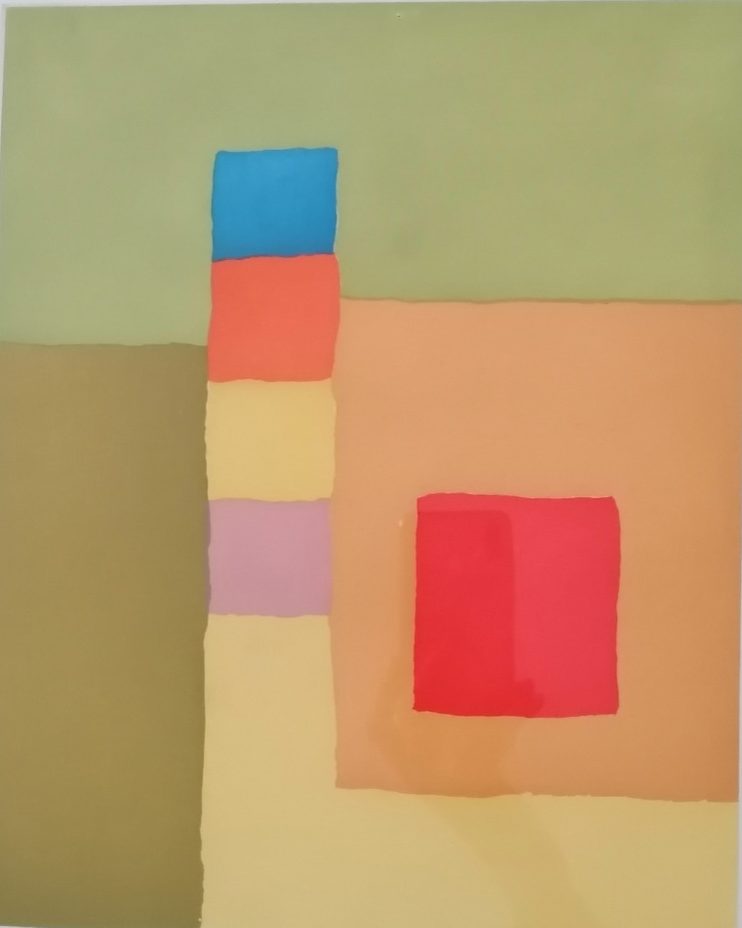
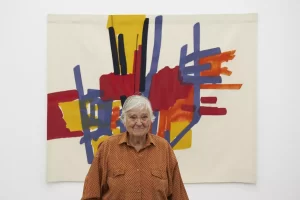
Etel Adnan is a Lebanese – American poet, essayist, and visual artist. Born to a Syrian father and a Greek mother, she studied philosophy and went to California in 1955, where she taught and became a painter. Although writing in French, then in English, she has been well known as a poet throughout the Arab world. In 2003, Adnan was named “arguably the most celebrated and accomplished Arab American author writing today” by the academic journal MELUS: Multi-Ethnic Literature of the United States. As a painter, she is internationally recognized, and her works are part of acquisitions by the Museum of Modern Art, New York; the Whitney Museum, New York; the Los Angeles Museum of Art; the British Museum; the Pompidou Center in Paris; the Modern Art, in Torino, Italy; the Museum of Modern Art in Tunis; the Sursock Museum in Beirut; and many private collections.
Her poetry has been put to music by composers such as Tania Leon, Henry Treadgill, Gavin Bryars, Annea Lockwood, Ben Ching Lam, Samir Odeh, and Zad Multaka. She works on a table, using a palette knife to apply oil paint onto the canvas – often directly from the tube – in firm swipes across the canvas. In 2012, a series of the artist’s brightly colored abstract paintings were exhibited as a part of documenta 13 in Kassel, Germany. In 2014 a collection of the artist’s paintings and tapestries were exhibited as a part of the Whitney Biennial at the Whitney Museum of American Art. Etel Adnan’s retrospective at Mathaf: Arab Museum of Modern Art in Doha, titled “Etel Adnan In All Her Dimensions” and curated by Hans Ulrich Obrist, featured eleven dimensions of Adnan’s practice. It included her early works, her literature, her carpets, and other types of art. She was named a Chevalier des Arts et des Lettres by the French Government in 2014. Throughout her career, Adnan received several awards for her writing including the Lambda Literary Award in 2013 and the RAWI Lifetime Achievement Award from the Radius of Arab-American Writers, to name a few. Adnan taught at Ahliah school for several years.
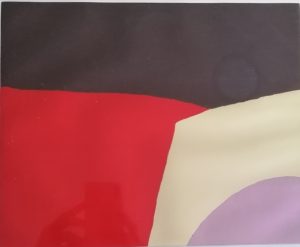
Mona Iskandar Ahliah Board of Trustees:
Etel Adnan has been described as “…The most celebrated and accomplished Arab-American author writing today”, as “One of our foremost living poets”, a “universal figure” and “Her life could be a study in displacement”. It is no easy task to write about Etel’s work, whether it is her poetry, novels, essays, plays, films or her art, specially that she often mixes poetry with prose, fiction with non-fiction, sometimes adding her paintings and drawings to top the cake. She is also an engaged writer and a powerful feminist voice and a member of the Peace Movement internationally.
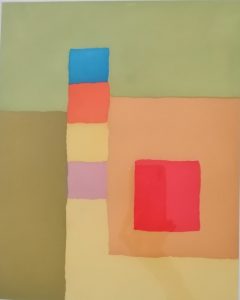
Etel is multilingual, brought up to speak Greek, Arabic, French, English and Turkish. She is well travelled and has resided in several countries. She is sensitive, visionary, and intelligent and has integrity that makes her a unique and complex person. She was born in 1925 in Beirut and raised by a Greek Christian mother and a high-ranking Ottoman officer, a Muslim from Syria.
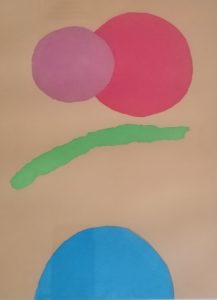



In the Lebanese capital, she was sent to two religious schools run by nuns who did not fail to treat her as different and inferior for not being a Catholic. After that, when she came to Ahliah School to teach French, she was pleasantly surprised to find that there were educational institutions that were liberal, non-sectarian, proud of their culture, open-minded and had a spirit of their own.
At 24, Etel went to Paris, where she received a degree in philosophy at the Sorbonne, and in 1955 she traveled to the U.S. and received post-graduate degrees from the University of California, Berkeley and Harvard University. Between 1952 and 1978 she taught philosophy at the Dominican University of California. When she first arrived in California as a young student, Etel was alone and lonely, and from her window she could see Mount Tamalpais in Northern San Francisco. In an interview she clarified:” It is not a spectacular mountain, 1000 m high only, but as soon as I saw it, I felt peace and it gave me comfort, and I developed a need for that mountain. It was my point of reference. This stable mountain, that looked stable, was never the same…. It is the mystery of permanence and change being tied together. You run after something that is there and not there…. The fog would hide it except the tip. To me it became like a person, I always come back to it to catch its different moods. It changes you as well.” Ever since, she has been drawing it and painting it in different moods and colours. She also wrote Journey to Mount Tamalpais, a book of essays and drawings, considered highly original in its content and structure. It is a poetic and philosophical meditation on the relationship between nature, man and art.
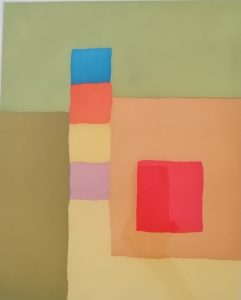



At the beginning, Etel wrote in French, but angered by the French in the Algerian War in the late 50s, and true to her convictions, she shifted to writing in English. She also wrote poetry to protest the Vietnam War. Only when she was 34 did she start painting.
In 1972, Etel went back to Beirut and worked as an editor and art critic for two newspapers, but left in 1976 as the civil war raged in Lebanon. In 1977, her novel Sitt Marie Rose was published in Paris. It has been translated to more than ten languages, and become a classic of “war literature”. It has attained the status of ‘an underground classic’ and is frequently taught at the university level in literature classes. It has also been adapted to the stage and produced in Dusseldorf. In 1977,she went back to California where she wrote the text of two documentary films on the Lebanese civil war.
Many of Adnan’s theater writings were adapted on stage in Lebanon, France, the U.S, Germany, Argentine and Italy. Her poem Jenine was also played in Greece in 2005. Some of her poetry was put to music, commissioned by the BBC and titled ‘Adnan Songbook’ and was performed in London, Cologne, Vancouver and San Francisco. Among other adaptations of her poetry to music, the French-Lebanese musician Zad Moultaka was commissioned to perform in Baalbek Festival in Lebanon, which went to Amsterdam as well. She was also a filmmaker and would film what she sees from her window, in the French New Wave style, where the artist shoots on location in a documentary style, using portable cameras. Adnan’s leporellos, painted leaflets, folded in an accordion style and expanding in size when opened, are made in series.
She mixes drawings and watercolour merged with poetry from Arab poets in their language and some of her own poetry. Other leporellos have flowers, landscapes, woods and inkpots as theme as well as Beirut, Paris and New York. There is a lot of playfulness in Etel’s work, especially that she uses strong colours. Her tapestries are probably instigated by nostalgia, reminding her of the carpets of her childhood in Beirut. She drew her tapestries in the abstract style and had them woven in Egypt.
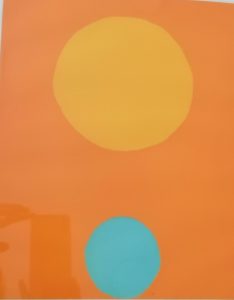



In 1989, Etel published The Arab Apocalypse that established her as a political writer, among other descriptions. Written in verse, it talks about the dislocation of the Arab world, its chaotic state and its turmoil. It was written after the first year of Lebanon’s civil war. She herself translated it from the French language to English. The poetry is powerful and her look at the dying sun is a metaphor of a spiritual trip. It is taught in classes in the U.S. Another poetry book A to Z, written in 1982, tells about life in N.Y. during the Three Mile Island nuclear accident, is an anti-war book.
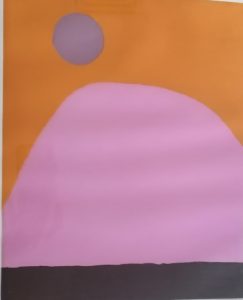



Prolific and eclectic, Etel Adnan has written a great number of books in almost all genres, styles, and structures and in different languages. She says that what is important is the feeling rather than the form, the painting, not the subject. All her life She has supported humanitarian causes with conviction. She has produced poetry, essays, novels, and also paintings, drawings, installations, leporellos, tapestry and films.
Etel Adnan is a Lebanese – American poet, essayist, and visual artist. Born to a Syrian father and a Greek mother, she studied philosophy and went to California in 1955, where she taught and became a painter. Although writing in French, then in English, she has been well known as a poet throughout the Arab world. In 2003, Adnan was named “arguably the most celebrated and accomplished Arab American author writing today” by the academic journal MELUS: Multi-Ethnic Literature of the United States. As a painter, she is internationally recognized, and her works are part of acquisitions by the Museum of Modern Art, New York; the Whitney Museum, New York; the Los Angeles Museum of Art; the British Museum; the Pompidou Center in Paris; the Modern Art, in Torino, Italy; the Museum of Modern Art in Tunis; the Sursock Museum in Beirut; and many private collections.
Her poetry has been put to music by composers such as Tania Leon, Henry Treadgill, Gavin Bryars, Annea Lockwood, Ben Ching Lam, Samir Odeh, and Zad Multaka. She works on a table, using a palette knife to apply oil paint onto the canvas – often directly from the tube – in firm swipes across the canvas. In 2012, a series of the artist’s brightly colored abstract paintings were exhibited as a part of documenta 13 in Kassel, Germany. In 2014 a collection of the artist’s paintings and tapestries were exhibited as a part of the Whitney Biennial at the Whitney Museum of American Art. Etel Adnan’s retrospective at Mathaf: Arab Museum of Modern Art in Doha, titled “Etel Adnan In All Her Dimensions” and curated by Hans Ulrich Obrist, featured eleven dimensions of Adnan’s practice. It included her early works, her literature, her carpets, and other types of art. She was named a Chevalier des Arts et des Lettres by the French Government in 2014. Throughout her career, Adnan received several awards for her writing including the Lambda Literary Award in 2013 and the RAWI Lifetime Achievement Award from the Radius of Arab-American Writers, to name a few. Adnan taught at Ahliah school for several years.
Mona Iskandar Ahliah Board of Trustees:
Etel Adnan has been described as “…The most celebrated and accomplished Arab-American author writing today”, as “One of our foremost living poets”, a “universal figure” and “Her life could be a study in displacement”. It is no easy task to write about Etel’s work, whether it is her poetry, novels, essays, plays, films or her art, specially that she often mixes poetry with prose, fiction with non-fiction, sometimes adding her paintings and drawings to top the cake. She is also an engaged writer and a powerful feminist voice and a member of the Peace Movement internationally.




Etel is multilingual, brought up to speak Greek, Arabic, French, English and Turkish. She is well travelled and has resided in several countries. She is sensitive, visionary, and intelligent and has integrity that makes her a unique and complex person. She was born in 1925 in Beirut and raised by a Greek Christian mother and a high-ranking Ottoman officer, a Muslim from Syria.




In the Lebanese capital, she was sent to two religious schools run by nuns who did not fail to treat her as different and inferior for not being a Catholic. After that, when she came to Ahliah School to teach French, she was pleasantly surprised to find that there were educational institutions that were liberal, non-sectarian, proud of their culture, open-minded and had a spirit of their own.
At 24, Etel went to Paris, where she received a degree in philosophy at the Sorbonne, and in 1955 she traveled to the U.S. and received post-graduate degrees from the University of California, Berkeley and Harvard University. Between 1952 and 1978 she taught philosophy at the Dominican University of California. When she first arrived in California as a young student, Etel was alone and lonely, and from her window she could see Mount Tamalpais in Northern San Francisco. In an interview she clarified:” It is not a spectacular mountain, 1000 m high only, but as soon as I saw it, I felt peace and it gave me comfort, and I developed a need for that mountain. It was my point of reference. This stable mountain, that looked stable, was never the same…. It is the mystery of permanence and change being tied together. You run after something that is there and not there…. The fog would hide it except the tip. To me it became like a person, I always come back to it to catch its different moods. It changes you as well.” Ever since, she has been drawing it and painting it in different moods and colours. She also wrote Journey to Mount Tamalpais, a book of essays and drawings, considered highly original in its content and structure. It is a poetic and philosophical meditation on the relationship between nature, man and art.




At the beginning, Etel wrote in French, but angered by the French in the Algerian War in the late 50s, and true to her convictions, she shifted to writing in English. She also wrote poetry to protest the Vietnam War. Only when she was 34 did she start painting.
In 1972, Etel went back to Beirut and worked as an editor and art critic for two newspapers, but left in 1976 as the civil war raged in Lebanon. In 1977, her novel Sitt Marie Rose was published in Paris. It has been translated to more than ten languages, and become a classic of “war literature”. It has attained the status of ‘an underground classic’ and is frequently taught at the university level in literature classes. It has also been adapted to the stage and produced in Dusseldorf. In 1977,she went back to California where she wrote the text of two documentary films on the Lebanese civil war.
Many of Adnan’s theater writings were adapted on stage in Lebanon, France, the U.S, Germany, Argentine and Italy. Her poem Jenine was also played in Greece in 2005. Some of her poetry was put to music, commissioned by the BBC and titled ‘Adnan Songbook’ and was performed in London, Cologne, Vancouver and San Francisco. Among other adaptations of her poetry to music, the French-Lebanese musician Zad Moultaka was commissioned to perform in Baalbek Festival in Lebanon, which went to Amsterdam as well. She was also a filmmaker and would film what she sees from her window, in the French New Wave style, where the artist shoots on location in a documentary style, using portable cameras. Adnan’s leporellos, painted leaflets, folded in an accordion style and expanding in size when opened, are made in series.
She mixes drawings and watercolour merged with poetry from Arab poets in their language and some of her own poetry. Other leporellos have flowers, landscapes, woods and inkpots as theme as well as Beirut, Paris and New York. There is a lot of playfulness in Etel’s work, especially that she uses strong colours. Her tapestries are probably instigated by nostalgia, reminding her of the carpets of her childhood in Beirut. She drew her tapestries in the abstract style and had them woven in Egypt.




In 1989, Etel published The Arab Apocalypse that established her as a political writer, among other descriptions. Written in verse, it talks about the dislocation of the Arab world, its chaotic state and its turmoil. It was written after the first year of Lebanon’s civil war. She herself translated it from the French language to English. The poetry is powerful and her look at the dying sun is a metaphor of a spiritual trip. It is taught in classes in the U.S. Another poetry book A to Z, written in 1982, tells about life in N.Y. during the Three Mile Island nuclear accident, is an anti-war book.




Prolific and eclectic, Etel Adnan has written a great number of books in almost all genres, styles, and structures and in different languages. She says that what is important is the feeling rather than the form, the painting, not the subject. All her life She has supported humanitarian causes with conviction. She has produced poetry, essays, novels, and also paintings, drawings, installations, leporellos, tapestry and films.
Etel Adnan is a Lebanese – American poet, essayist, and visual artist. Born to a Syrian father and a Greek mother, she studied philosophy and went to California in 1955, where she taught and became a painter. Although writing in French, then in English, she has been well known as a poet throughout the Arab world. In 2003, Adnan was named “arguably the most celebrated and accomplished Arab American author writing today” by the academic journal MELUS: Multi-Ethnic Literature of the United States. As a painter, she is internationally recognized, and her works are part of acquisitions by the Museum of Modern Art, New York; the Whitney Museum, New York; the Los Angeles Museum of Art; the British Museum; the Pompidou Center in Paris; the Modern Art, in Torino, Italy; the Museum of Modern Art in Tunis; the Sursock Museum in Beirut; and many private collections.
Her poetry has been put to music by composers such as Tania Leon, Henry Treadgill, Gavin Bryars, Annea Lockwood, Ben Ching Lam, Samir Odeh, and Zad Multaka. She works on a table, using a palette knife to apply oil paint onto the canvas – often directly from the tube – in firm swipes across the canvas. In 2012, a series of the artist’s brightly colored abstract paintings were exhibited as a part of documenta 13 in Kassel, Germany. In 2014 a collection of the artist’s paintings and tapestries were exhibited as a part of the Whitney Biennial at the Whitney Museum of American Art. Etel Adnan’s retrospective at Mathaf: Arab Museum of Modern Art in Doha, titled “Etel Adnan In All Her Dimensions” and curated by Hans Ulrich Obrist, featured eleven dimensions of Adnan’s practice. It included her early works, her literature, her carpets, and other types of art. She was named a Chevalier des Arts et des Lettres by the French Government in 2014. Throughout her career, Adnan received several awards for her writing including the Lambda Literary Award in 2013 and the RAWI Lifetime Achievement Award from the Radius of Arab-American Writers, to name a few. Adnan taught at Ahliah school for several years.
Mona Iskandar Ahliah Board of Trustees:
Etel Adnan has been described as “…The most celebrated and accomplished Arab-American author writing today”, as “One of our foremost living poets”, a “universal figure” and “Her life could be a study in displacement”. It is no easy task to write about Etel’s work, whether it is her poetry, novels, essays, plays, films or her art, specially that she often mixes poetry with prose, fiction with non-fiction, sometimes adding her paintings and drawings to top the cake. She is also an engaged writer and a powerful feminist voice and a member of the Peace Movement internationally.




Etel is multilingual, brought up to speak Greek, Arabic, French, English and Turkish. She is well travelled and has resided in several countries. She is sensitive, visionary, and intelligent and has integrity that makes her a unique and complex person. She was born in 1925 in Beirut and raised by a Greek Christian mother and a high-ranking Ottoman officer, a Muslim from Syria.




In the Lebanese capital, she was sent to two religious schools run by nuns who did not fail to treat her as different and inferior for not being a Catholic. After that, when she came to Ahliah School to teach French, she was pleasantly surprised to find that there were educational institutions that were liberal, non-sectarian, proud of their culture, open-minded and had a spirit of their own.
At 24, Etel went to Paris, where she received a degree in philosophy at the Sorbonne, and in 1955 she traveled to the U.S. and received post-graduate degrees from the University of California, Berkeley and Harvard University. Between 1952 and 1978 she taught philosophy at the Dominican University of California. When she first arrived in California as a young student, Etel was alone and lonely, and from her window she could see Mount Tamalpais in Northern San Francisco. In an interview she clarified:” It is not a spectacular mountain, 1000 m high only, but as soon as I saw it, I felt peace and it gave me comfort, and I developed a need for that mountain. It was my point of reference. This stable mountain, that looked stable, was never the same…. It is the mystery of permanence and change being tied together. You run after something that is there and not there…. The fog would hide it except the tip. To me it became like a person, I always come back to it to catch its different moods. It changes you as well.” Ever since, she has been drawing it and painting it in different moods and colours. She also wrote Journey to Mount Tamalpais, a book of essays and drawings, considered highly original in its content and structure. It is a poetic and philosophical meditation on the relationship between nature, man and art.




At the beginning, Etel wrote in French, but angered by the French in the Algerian War in the late 50s, and true to her convictions, she shifted to writing in English. She also wrote poetry to protest the Vietnam War. Only when she was 34 did she start painting.
In 1972, Etel went back to Beirut and worked as an editor and art critic for two newspapers, but left in 1976 as the civil war raged in Lebanon. In 1977, her novel Sitt Marie Rose was published in Paris. It has been translated to more than ten languages, and become a classic of “war literature”. It has attained the status of ‘an underground classic’ and is frequently taught at the university level in literature classes. It has also been adapted to the stage and produced in Dusseldorf. In 1977,she went back to California where she wrote the text of two documentary films on the Lebanese civil war.
Many of Adnan’s theater writings were adapted on stage in Lebanon, France, the U.S, Germany, Argentine and Italy. Her poem Jenine was also played in Greece in 2005. Some of her poetry was put to music, commissioned by the BBC and titled ‘Adnan Songbook’ and was performed in London, Cologne, Vancouver and San Francisco. Among other adaptations of her poetry to music, the French-Lebanese musician Zad Moultaka was commissioned to perform in Baalbek Festival in Lebanon, which went to Amsterdam as well. She was also a filmmaker and would film what she sees from her window, in the French New Wave style, where the artist shoots on location in a documentary style, using portable cameras. Adnan’s leporellos, painted leaflets, folded in an accordion style and expanding in size when opened, are made in series.
She mixes drawings and watercolour merged with poetry from Arab poets in their language and some of her own poetry. Other leporellos have flowers, landscapes, woods and inkpots as theme as well as Beirut, Paris and New York. There is a lot of playfulness in Etel’s work, especially that she uses strong colours. Her tapestries are probably instigated by nostalgia, reminding her of the carpets of her childhood in Beirut. She drew her tapestries in the abstract style and had them woven in Egypt.




In 1989, Etel published The Arab Apocalypse that established her as a political writer, among other descriptions. Written in verse, it talks about the dislocation of the Arab world, its chaotic state and its turmoil. It was written after the first year of Lebanon’s civil war. She herself translated it from the French language to English. The poetry is powerful and her look at the dying sun is a metaphor of a spiritual trip. It is taught in classes in the U.S. Another poetry book A to Z, written in 1982, tells about life in N.Y. during the Three Mile Island nuclear accident, is an anti-war book.




Prolific and eclectic, Etel Adnan has written a great number of books in almost all genres, styles, and structures and in different languages. She says that what is important is the feeling rather than the form, the painting, not the subject. All her life She has supported humanitarian causes with conviction. She has produced poetry, essays, novels, and also paintings, drawings, installations, leporellos, tapestry and films.